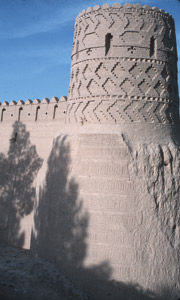Form and Function in Decorated Earthen Surfaces
Ed Crocker
Mud need not be homely, despite the condescending implication of the time-honored adage regarding fences built with earth. On the contrary, earthen walls in their universe of variety range from the subtly modest to the exquisite. In southern Africa, the Ndebele people build walls with steps and finials that they whitewash and then paint with stunning geometric patterns in intense colors. In central Iran, along the Silk Road, the caravanserai are plastered with a fine, light earth and given a white trim of local gypsum. Kassena women in Burkina Faso decorate the upper levels of their courtyard houses with figures intended to resemble guardians on the roof to approaching visitors, and in Mali the Sorko create south-facing facades in high geometric relief.
 Decorated surfaces on exterior walls serve many functions, some of which are quite surprising. In sub-Saharan Africa and the deserts of Saudi Arabia it is not uncommon to find intricate patterns created by applying hemispheres of mud to the vertical surface, or incising deep patterns in the still-fresh mud. Though intriguing to look at, these motifs have more of a technical than an aesthetic purpose. A flat wall provides the most exposed surface to the sun and thus heats up more rapidly. The topography created by the decorations casts shadows regardless of the overhead position of the sun that help keep the wall cooler.
Decorated surfaces on exterior walls serve many functions, some of which are quite surprising. In sub-Saharan Africa and the deserts of Saudi Arabia it is not uncommon to find intricate patterns created by applying hemispheres of mud to the vertical surface, or incising deep patterns in the still-fresh mud. Though intriguing to look at, these motifs have more of a technical than an aesthetic purpose. A flat wall provides the most exposed surface to the sun and thus heats up more rapidly. The topography created by the decorations casts shadows regardless of the overhead position of the sun that help keep the wall cooler.
Similarly, the brilliant white of the toothed mosque in Bobo Diolasso and the whitewashed domes of San Javier del Bac reflect the intense sunlight and so help maintain a livable temperature within.
In New Mexico where the temperatures are more moderate, it is unusual to find exotic decorations on the exterior. We do, however, have some fascinating interior decorative traditions that come to us from both Native and Iberian sources.
The Zuni use a lovely white material that in their language is called Que'chi-pa. It is not used on pottery, but exclusively on interior walls as a whitewash. It is applied with a fresh rabbit pelt having been mixed only with water. It smells like really fresh dough and good enough to eat. I have been to the cave where it is borrowed and, with permission, had some of the material tested by the University of Pennsylvania. I was curious as to the composition, assuming it to be either a gypsum- or lime-based substance and getting its adhesive qualities from those compounds. Spectrographic analysis showed it to be pure silica. In other words, sand; very, very fine sand. So why does it adhere to a wall? The rabbit pelt floats clay particles out of the plaster substrate to the surface that bond it.
The Acoma have something that I think is probably identical. If you have visited the monumental San Estevan del Rey church, you may remember the pink dado around the base of the interior walls. That is an unamended material that they get from deposits just under the caprock of the mesa. I have not been to the pits, but my daughter has, and has helped mine, mix and apply it in a fashion similar to the Zuni.
A later tradition, usually associated with the Hispanic architecture of northern New Mexico, is often referred to as calcimine. My understanding is that the material, which used to be sold commercially as Kalsomine, had a zinc oxide base with a clear glue as a binder. Local verbal tradition holds that it is a lime-based paint, sometimes containing admixtures such as salt or flour and tinted with mineral oxides. In either case, it was very common up until the 1940s and is found in some of our purest, which is to say less maintained, buildings. It was fairly unstable (except for the color which was amazingly durable), and tended to rub off on the Sunday suit.
The next time you hear an allusion to something that is "homely as a mud fence," remind the speaker of the Ndebele and the Zuni and ask if what they really mean is "comely."

